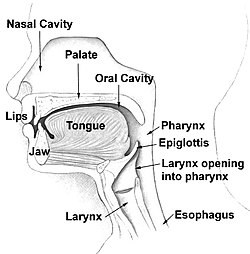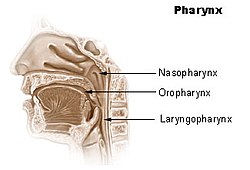User:Kaitlynleee/article
| Kaitlynleee/article | |
|---|---|
 Head and neck. | |
 Pharynx | |
| Details | |
| Artery | pharyngeal branches of ascending pharyngeal artery, ascending palatine, descending palatine, pharyngeal branches of inferior thyroid |
| Vein | pharyngeal veins |
| Nerve | pharyngeal plexus |
| Anatomical terminology | |
Oropharyngeal cancer is a disease which malignant cells form in the tissue of oropharynx. Oropharynx is a middle part of the throat which includes the base of the tongue, the tonsils, the soft palate, and the walls of the pharynx.[1]
Studies
[edit]For patients with advanced oropharyngeal cancer the combination of radiotherapy and chemotherapy appears to be as efficient as surgurical management. Shiley and her coworkers had a study to compare how the two approaches maintain swallowing function. They studied 27 patients who underwent the advanced stage (III and IV) of oropharyngeal cancer. Among those patients, 67% had base of tongue lesions and 82% of them used gastrostomy tube either before or during the treatment. Three months after the chemoradiation, 33% of the patients were consuming all nutrition orally, 45% had some oral intake but still had the tube feeding, and 22% had no oral intake at all. The results showed that the short-term incidence of gastrostomy tube dependence after chemo radiation was similar to that after surgical management of oropharyngeal cancer at their institution. [2]
Symptoms of Oropharyngeal cancer
[edit]Following are the possible sign of oropharyngeal cancer. [3] [1]
- A sore throat that persists
- Pain or difficulty with swallowing
- Unexplained weight loss
- Voice changes
- Ear pain
- A lump in the back of the throat or mouth
- A lump in the neck
- A dull pain behind the sternum
- Cough
Risks of Oropharyngeal cancer
[edit]Following are the risk factors that can increase the risk of developing oropharyngeal cancer. [3]
- Smoking and chewing tobacco.
- Heavy alcohol use.
- A diet low in fruits and vegetables.
- Drinking maté, a stimulant drink common in South America.
- Chewing betel quid, a stimulant commonly used in parts of Asia.
- Being infected with human papilloma virus (HPV).
The prognosis for people with oropharyngeal cancer depends on the age and health of the person and the stage of the disease. It is important for people with oropharyngeal cancer to have follow-up exams for the rest of their lives as cancer can occur in nearby areas. In addition, it is important to eliminate risk factors such as smoking and drinking, which increase the risk for second cancers. [1]
Ways of the cancer spreading in the body
[edit]There are three ways of cancer spreading in the body.[3]
- Cancer invades the surrounding normal tissues.
- Cancer invades the lymph system and travels through the lymph vessels to other places in the body.
- Cancer invades the veins and capillaries and travels through the blood to other places in the body.
Stages of the Oropharyngeal cancer
[edit]Stage 0 carcinoma in situ
[edit]Abnormal cells are found in the lining of the oropharynx, These may become cancer and spread into nearby normal tissue.
Stage 1
[edit]Cancer has formed and is 2 centimeters or smaller and has not spread outside the oropharynx.
Stage 2
[edit]Cancer has formed and is larger than 2 centimeters, but not larger than 4 centimeters. Also it has not yet spread outside the oropharynx.
Stage 3
[edit]- Cancer is larger than 4 centimeters and has not spread outside the oropharynx
- Any size and has spread to only one lymph node on the same side of the neck as the cancer. The lymph node with cancer is 3 centimeters or smaller.
Stage 4A
[edit]- Cancer has spread to tissues near the oropharynx, including the voice box, roof of the mouth, lower jaw, muscle of the tongue, or central muscles of the jaw, and may have spread to one or more nearby lymph nodes, none larger than 6 centimeters.
- Cancer is any size and has spread to one lymph node that is larger than 3 centimeters but not larger than 6 centimeters on the same side of the neck as the cancer, or to more than one lymph node, none larger than 6 centimeters, on one of both sides of the neck.
Stage 4B
[edit]- Cancer surrounds the main artery in the neck or has spread to bones in the jaw or skull, to muscle in the side of the jaw, or to the upper part of the throat behind the nose, and may have spread to nearby lymph nodes
- Cancer has spread to a lymph node that is larger than 6 centimeters and may have spread to tissues around the oropharynx.
Stage 4C
[edit]Cancer has spread to other parts of the body; the tumor may be any size and may have spread to lymph nodes.
See Also
[edit]References
[edit]- ^ a b c Adelstein, David, Steven Ball, and Henry Blair. "Oropharyngeal Cancer Overview." Cleveland Clinic. Cleveland Clinic, 15 Mar. 2005. Web. 16 Oct. 2009. <http://my.clevelandclinic.org/>.
- ^ SG, Shiley "Swallowing Function after Chemoradiation for Advanced Stage Oropharyngeal Cancer." Abstracts in Hematology & Oncology 9.4 (Dec 1, 2006): 20. Expanded Academic ASAP. Gale. 15 Oct. 2009
- ^ a b c d National Cancer Institute. "Oropharyngeal Cancer Treatment." National Cancer Institute. U.S. National Institute of Health, 28 Aug. 2009. Web. 16 Oct. 2009. <http://cancer.gov>.
{{Tumors}} {{Tumors of lip, oral cavity and pharynx}}
{{Nose anatomy}}
{{Mouth anatomy}}
{{Digestive_system}}
{{DEFAULTSORT: Oral and maxillofacial surgery}}
Category: Oral and maxillofacial surgery
Category: Otolaryngology
Category: Types of cancer
